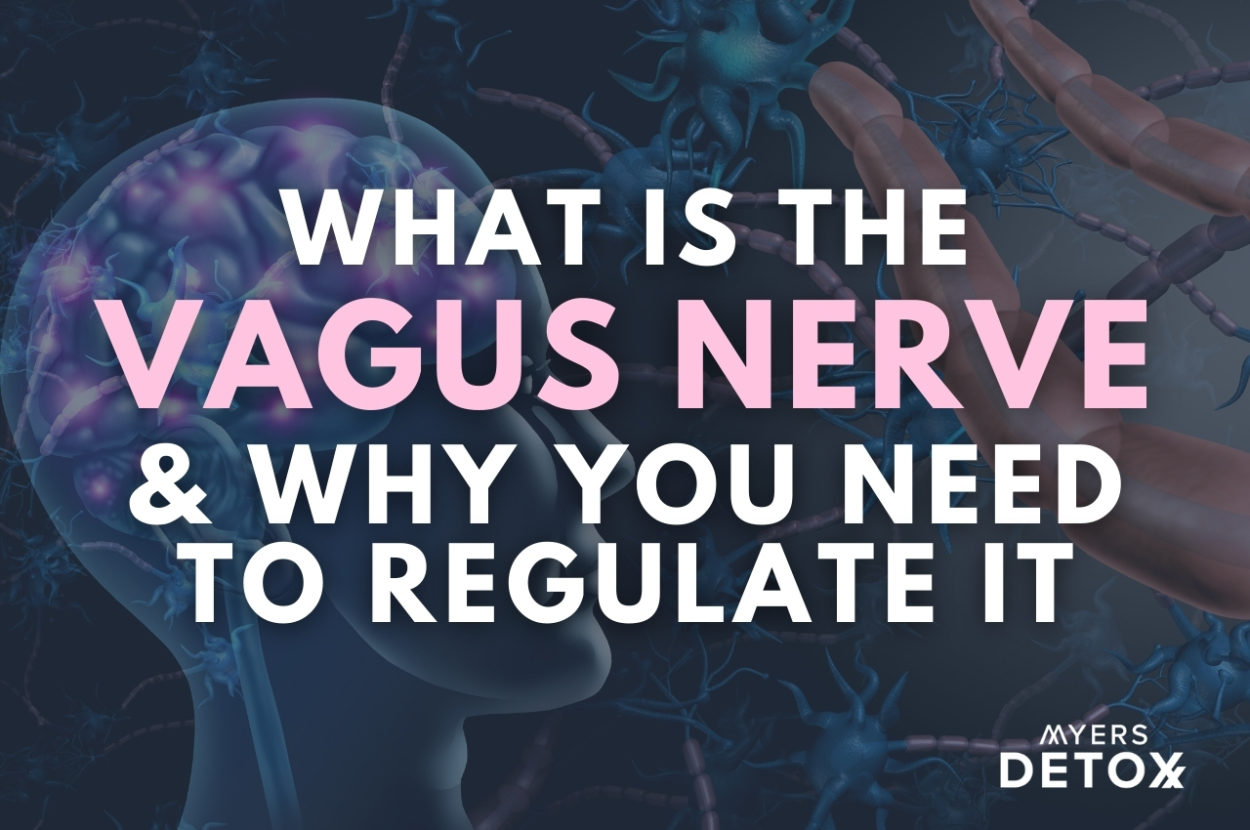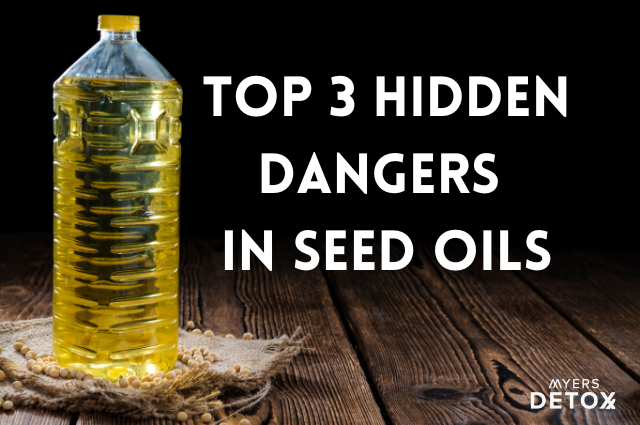There’s been a lot of talk about the vagus nerve recently, especially as people are trying to find ways to relax and deal with the stress of the last 16 months.
Understanding vagal tone and how it can impact your health, digestion, mood, and detoxification pathways could be the missing link between you and that peace of mind that’s seemingly been just out of reach.
In this article, you’ll learn
- The vital function that the vagus nerve plays in the gut-brain connection
- How without proper vagal tone, your detox pathways can’t do their job
- A few practical and simple ways to stimulate your vagus nerve
- Why your digestion, sleep, and mood may not be what they used to be, and what to do about it.
What Is The Vagus Nerve?
The vagus nerve is the longest and most complex of your cranial nerves, which are a group of nerves emanating from your brain’s nervous tissue. It runs from your brain, through your face and thorax, all the way to your abdomen.
As researchers continue to learn more about the gut-brain connection, the vagus nerve has become an area of interest as its function relates to the bi-direction communication between your brain and your digestive tract[1].
To fully grasp the role that the vagus nerve plays, we first have to talk a bit about your autonomic nervous system (ANS).
Your ANS has two branches, sympathetic mode, and parasympathetic mode. In sympathetic mode, your body goes into fight or flight, while in parasympathetic mode, your body is signaled to rest and digest.
In stressful situations, your sympathetic nervous system (SNS) gets activated, and your heart rate speeds up, blood vessels constrict, blood pressure increases, pupils dilate, and your digestive system slows down. Your body takes these measures because your primitive brain assesses any threat (even an argument with your boss) as a life or death situation.
In parasympathetic mode, on the other hand, your body relaxes. This allows you to experience more movement through your digestive tract, your blood vessels dilate, blood pressure decreases, your salivary glands are stimulated (signaling you’re safe — you can relax and nourish yourself), and your bronchioles are dilated, allowing for deeper, fuller breaths[2][3].
In short, you could say that activating your parasympathetic mode helps to put you into a place of mental clarity and relaxation, while sympathetic mode narrows your focus on one thing — survival.
So, where does your vagus nerve fit in?
The vagus nerve is the primary component of the parasympathetic nervous system (PNS). When this nerve is stimulated, it triggers your body into rest, digest, and repair.
How The Vagus Nerve Assists In Detox
As you can imagine, when your body is corralling all of its resources to assist you in survival, everyday functions like digestion and detox take the back burner. It would be quite inconvenient if you were running from a tiger, and then all of a sudden, you realized you needed to use the restroom.
This is why getting your body into parasympathetic mode is crucial if you want to be able to optimize your detoxification pathways.
Through its impact on your PNS, vagus nerve stimulation tells your body you’re safe, and you can get back to maintenance and repair instead of just focusing on survival.
To bring things a bit more into focus, detoxification is no small feat for your body. Although this is a process that’s happening all the time, it requires energy and resources to pull toxins from your tissues, neutralize them in your blood, and eliminate them through sweat, urine, breath, and feces.
Therefore, things like strong digestion, healthy blood flow, robust immunity, and proper sleep are all crucial components to the big picture of detox. And activating your parasympathetic nervous system is the best way to achieve all of these functions[4][5][6].
How To Stimulate Your Vagus Nerve
Stimulating your vagus nerve, also referred to as increasing your vagal tone, helps your body get into parasympathetic mode. Increasing vagal tone not only helps you to detoxify, but it also assists digestion, increases heart rate variability (a key marker for resilience to stress), calms your mind, and lowers your blood pressure.
You can use several tools to stimulate your vagus nerve and bring your mind and body into a state of ease.
These include:
Cold Stimulation
Research shows that cold stimulation (such as a 30-second cold shower) can increase your body’s resistance to stress. By stimulating your body with a cold temperature, it activates your vagus nerve and, in turn, enhances your heart rate variability[7].
Try cold stimulation while you’re showering. At first, it may be a little uncomfortable, but you can build up to colder temperatures, or just start with 10 seconds and add on from there until you reach a full 30 seconds.
Deep Breathing
Deep breathing offers a simple yet very powerful way to enhance vagal tone. While there are hundreds of breathing techniques out there, deep belly breathing is particularly helpful for stimulating a sense of calm[8].
To practice deep breathing, sit comfortably in an upright position with your back straight and shoulders relaxed. Begin by taking a slow inhale through your nose, focusing on filling up your belly (not your chest) with air. Your belly should become full as if you are pregnant with air.
Next, release the breath out of your nose slowly and gently until your belly is empty of air. Take a pause at the bottom of the breath, and repeat.
You can follow this breath for as long as you like, but try to do at least five inhales and exhales.
Loving-Kindness Meditation
Research shows that practicing loving-kindness meditation has a direct impact on positive emotions and vagal tone. Furthermore, once you start generating positive emotions through meditation, vagal tone continues to increase, resulting in more positive emotions — like a positive snowball effect[9].
Loving-kindness meditation offers love and acceptance to yourself and others and is an excellent way to relieve worries and stress while opening your heart.
To practice loving-kindness meditation, find a quiet place where you can relax. Take a moment to center yourself with a few deep breaths, then imagine that you are breathing out tension and breathing in love.
Once you feel settled, start to repeat three or four positive phrases to yourself. Some examples include:
- May I be happy
- May I be healthy
- May I be safe
- May I be loved
- May I be peaceful
Allow yourself to be fully present with whatever phrases you choose for yourself, fully feeling the intention of their meaning.
Next, begin to extend this loving-kindness to those closest to you (friends, family, partners). Repeat the phrases, sending love to anyone that comes to mind.
You can then continue to branch out to acquaintances, neighbors, coworkers, and if you’re feeling especially open even to people that you find challenging.
Finally, extend this loving-kindness to the whole world, imaging the world receiving this love and peace from your heart.
When the meditation feels complete, gently open your eyes and give yourself a moment to have gratitude for yourself and your practice.
Singing and Laughter
Much like deep breathing can act as a way to stimulate your vagus nerve, singing and laughter also initiate a deeper breathing pattern, which acts in a similar way.
Research shows that laughter can have a profound impact not only on mood but on health in general. In fact, there are even classes that people can take as a therapeutic intervention that involves laughter and exercise for mental health.
However, you don’t have to take a class to get the benefits of laughter; just call up a friend that knows how to make you laugh, or watch a funny movie or stand up. In our busy lives, we often forget to prioritize things like laughter, but it truly is an important part of the recipe for health[10].
Yoga
Yoga takes the best of meditation and breathwork and combines them into one dynamic vagal stimulating exercise[11].
You can try any form of yoga that speaks to you, as long as your focus is on your breath and you are actively engaging in the postures.
There are many ways to practice yoga (even in today’s conditions). If the yoga studies around you are temporarily closed, try an online class or get together with a group of socially distanced friends for a fun gathering of movement.
Wearable Technology
By now you know that regularly practicing vagus nerve exercises will improve your stress resilience, brain function, immune health, digestion, and – best of all – help you feel more relaxed and centered.
But sometimes you need a little boost! For what I like to call “extra strength” levels of toning, I like to lean on modern technology.
Here are a few of my favorite wearable tech devices that can be used to strengthen your vagus nerve, each backed by multiple studies.
Apollo Neuro
Why it helps: The Apollo Neuro is a device you wear on your wrist or ankle. Developed by doctors and neuroscientists and backed by multiple studies, the Apollo sends gentle vibrational signals to your body that trigger activation of the “rest and digest” parasympathetic nervous system — the domain of your vagus nerve. The Apollo also works great for children who may resist the other vagus nerve exercises.
How to do it: Set the Apollo to activate the appropriate energy levels throughout the day: Energized in the morning, focused and calm during the day, and relaxed and unwinding in the evening. You can also wear it while you sleep to support deeper, more restful sleep.
Dosage: The Apollo is safe to wear as much as you’d like to support a calm yet alert state.
“I wear the Apollo every day as it helps bring down my stress levels while keeping me alert, focused, and positive. It has been an invaluable tool in helping me better manage all aspects of my life.”
—Wendy Myers, founder of Myers Detox
Modius
Why it helps: The Modius is worn on your head and delivers small electrical impulses to the nerves behind your ear. This has been shown to stimulate the vagus nerve and the parasympathetic nervous system. The Modius is also designed specifically to support people losing weight by reducing cravings and reduce appetite.
How to do it: Simply place the device on your head and use the Modius every day for one hour.
Dosage: Start with a low setting and gradually increase the intensity as you become more accustomed to the therapy.
To learn more about how to reset your vagus nerve and restore inner calm, check out this article.
Takeaway
Increasing your vagal tone can bring balance and peace to both your body and mind. One thing you likely found that all of the above suggestions have in common is that they’re practices that bring us some level of joy or contentment.
In this way, you can think of your vagus nerve as a conductor for peace and wellbeing.
It is all too common in our society to get caught up in the day to day activities of our lives and forget that we are whole beings that deserve to feel happy and well every day.
Increasing vagal tone is a simple way to enhance the quality of your life, support detoxification, and give yourself the loving care that you deserve.










